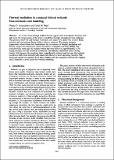| dc.contributor.author | Andradottir, Hrund O. | |
| dc.contributor.author | Nepf, Heidi | |
| dc.date.accessioned | 2012-02-02T19:05:46Z | |
| dc.date.available | 2012-02-02T19:05:46Z | |
| dc.date.issued | 2000-10 | |
| dc.date.submitted | 2000-05 | |
| dc.identifier.issn | 0043-1397 | |
| dc.identifier.uri | http://hdl.handle.net/1721.1/69012 | |
| dc.description.abstract | As a river flows through shallow littoral regions such as wetlands, forebays, and side arms, the temperature of the water is modified through atmospheric heat exchange. This process, which we call thermal mediation, can control the initial fate of river-borne nutrient and contaminant fluxes within a lake or reservoir. This paper presents temperature observations that demonstrate the occurrence of thermal mediation and directly support the theoretical results derived by Andradóttir and Nepf [2000]. The measurements show that the wetland warms the river inflow by approximately 1–3[degrees]C during summer and fall nonstorm conditions. Less thermal mediation occurs during storms, both because the residence time is significantly reduced and because the wetland circulation shifts from laterally well mixed (low flows) to short-circuiting (storms). The dead-zone model can simulate both these regimes and the transition between the regimes and is therefore a good choice for wetland modeling. | en_US |
| dc.description.sponsorship | National Institute of Environmental Health Sciences (Superfund Basic Research Program, grant P42-ES04675) | en_US |
| dc.language.iso | en_US | |
| dc.publisher | American Geophysical Union | en_US |
| dc.relation.isversionof | http://dx.doi.org/10.1029/2000WR900201 | en_US |
| dc.rights | Article is made available in accordance with the publisher's policy and may be subject to US copyright law. Please refer to the publisher's site for terms of use. | en_US |
| dc.source | Prof. Nepf | en_US |
| dc.title | Thermal Mediation in a Natural Littoral Wetland: Measurements and Modeling | en_US |
| dc.type | Article | en_US |
| dc.identifier.citation | Andradóttir, Hrund Ó., and Heidi M. Nepf. “Thermal Mediation in a Natural Littoral Wetland: Measurements and Modeling.” Water Resources Research 36.10 (2000): 2937–2946. ©2000 American Geophysical Union. | en_US |
| dc.contributor.department | Massachusetts Institute of Technology. Department of Civil and Environmental Engineering | en_US |
| dc.contributor.approver | Nepf, Heidi | |
| dc.contributor.mitauthor | Nepf, Heidi | |
| dc.contributor.mitauthor | Andradottir, Hrund O. | |
| dc.relation.journal | Water Resources Research | en_US |
| dc.eprint.version | Final published version | en_US |
| dc.type.uri | http://purl.org/eprint/type/JournalArticle | en_US |
| eprint.status | http://purl.org/eprint/status/PeerReviewed | en_US |
| dspace.orderedauthors | Andradóttir, Hrund Ó.; Nepf, Heidi M. | en |
| mit.license | PUBLISHER_POLICY | en_US |
| mit.metadata.status | Complete | |
